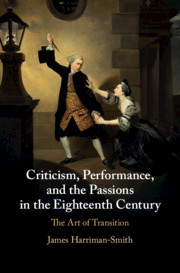Book contents
- Criticism, Performance, and the Passions in the Eighteenth Century
- Criticism, Performance, and the Passions in the Eighteenth Century
- Copyright page
- Dedication
- Contents
- Illustrations
- Acknowledgements
- Note on Style
- Introduction
- Chapter 1 Dramatic Transition
- Chapter 2 Zara
- Chapter 3 Odes
- Chapter 4 King Lear
- Chapter 5 Dramatic Character
- Coda
- Notes
- Bibliography
- Index
Chapter 4 - King Lear
Published online by Cambridge University Press: 02 March 2021
- Criticism, Performance, and the Passions in the Eighteenth Century
- Criticism, Performance, and the Passions in the Eighteenth Century
- Copyright page
- Dedication
- Contents
- Illustrations
- Acknowledgements
- Note on Style
- Introduction
- Chapter 1 Dramatic Transition
- Chapter 2 Zara
- Chapter 3 Odes
- Chapter 4 King Lear
- Chapter 5 Dramatic Character
- Coda
- Notes
- Bibliography
- Index
Summary
King Lear was considered as David Garrick’s most significant part. I argue that this judgement depends on the extent to which this play (following Nahum Tate’s and Garrick’s alterations of Shakespeare’s text) offered a remarkable sequence of contrasting emotions through the performance of madness. The representation of Lear’s insanity required a mastery of the art of transition, yet Garrick’s practice of such an art was not without its challenges. While his critics explored the aesthetic, sociological, and psychological questions of how to perform a king’s madness, performance editions and promptbook markings reveal Garrick’s own efforts to render the part’s transitions with everything from innovative make-up to minute textual editing. Such transitions, and those of Edgar’s pretend madness, ultimately performed an essential function, moderating and so maintaining spectators’ emotional engagement in the Tate-Garrick tragedy. Such moderation is alien to Shakespeare’s play of 1608, and, while the eighteenth-century Lear can tell us much about a celebrated performance in Georgian London, it thus also serves as a critical standpoint for re-evaluating the structures of Jacobean tragedy.
Keywords
- Type
- Chapter
- Information
- Criticism, Performance, and the Passions in the Eighteenth CenturyThe Art of Transition, pp. 116 - 152Publisher: Cambridge University PressPrint publication year: 2021

